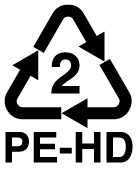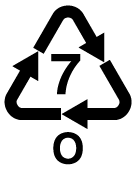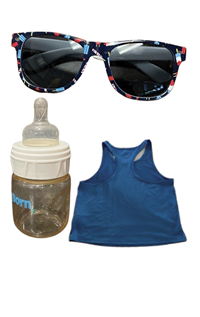Know the Numbers: Reduce Plastic Waste
The widespread production of plastic has existed since the 1950s and has brought many changes to our society. There is no question that the existence of plastic in medical equipment, housing materials and cars has numerous benefits. However, the increased prevalence of single-use, disposable plastics has also caused many negative impacts to animal and human health and ecosystems at the same time. Due to our throwaway culture, these plastics are now in greater demand than any other form of plastic. Nearly 40 percent of all plastics produced are disposable plastics. In addition, plastic production is expected to double worldwide by 2040.
While many people believe they can take all plastics to their local recycling center or add the materials to their curbside bin, the reality is most plastics are not accepted by community recycling programs. Only about 7 percent of plastics are recycled in the U.S. annually, and the other 80 percent end up in landfills where they will remain for hundreds of years. Most plastics are made from fossil fuels and do not biodegrade over time. Instead, they often break apart into tiny pieces called micro- or nano-plastics. These tiny particles can end up in our oceans and waterways causing negative impacts to aquatic life and birds.
Consumers often believe that the “chasing arrows” symbols on many plastic containers indicate that the items are accepted by their local recycling program. However, these symbols do not indicate that an item can be recycled. They explain the type of resin material a plastic item is made from. These symbols are officially called plastic resin identification codes (see Table 1).
There are seven types of plastic resins. Resins #1 and 2 are most commonly collected for recycling in the U.S. The rest can contain additives, colorants and toxins which makes them difficult to recycle. Another factor that makes resins #3–7 difficult to recycle is they are not as commonly used as #1 and 2. Lesser used plastics are less valuable to people who buy recyclables, thus making the collection of these materials unfeasible in sustaining a business. The greater amount of a material to collect, the higher the value of the material. The value of recyclables is an integral component of the recycling system.
Reducing plastic waste is essential because it prevents pollution, saves natural resources, frees up landfill space, and reduces greenhouse gases that contribute to climate change. We all can make changes to our lifestyles by reducing plastic waste in the following ways:
- Refuse unnecessary plastics. One of the simplest ways to reduce plastic waste, is to simply refuse unnecessary plastics such as plastic drinking straws, cup lids, and shopping bags when they are offered to you. Also, refuse products that are packaged with unnecessary plastic such as prepackaged snacks and produce.
- Replace disposable plastics with reusables. There are numerous ways to replace disposable plastics with reusable items to reduce household plastic waste. Some of these include using reusable shopping bags at the store or drinking from a reusable water bottle. Another option is replacing plastic cups, utensils, and plates with reusable glass, metal, or ceramic tableware. Consider swapping out liquid soap stored in plastic disposable bottles with bath bar soap and powder detergent stored in paper boxes. In addition, storing food in reusable storage containers versus plastic ziplock bags is a great alternative.
- Check local recycling guidelines for plastics. Understand which plastics are accepted in your area by contacting your local government for details. Also, visit the MS Department of Environmental Quality (MDEQ) Recycling Directory.
- Recycle plastic correctly. Check containers for resins #1 and 2. If a container does not have a code, remember “when in doubt, leave it out”. Putting non-recyclable plastics and recyclables in the same bin is considered contamination, which will result in recyclers sending an entire load to a landfill. Also, plastics must be clean to be recycled. Wash out any residue left in containers. Finally, never put plastic bags in with recyclables! They are a safety hazard and jam up recycling machinery. Instead, take plastic bags and other plastic films to your local grocery store or other participating retailers.
- Buy in bulk. Buying in bulk reduces the amount of disposable plastic packaging used to hold food.
- Buy less clothing. Much of the clothing we wear today is made of blended fiber often containing plastic. It is extremely hard to separate plastic from these fabrics when recycling. This results in about 85 percent of clothing and footwear in the U.S. ending up in landfills or being incinerated. Only 15 percent of clothing gets recycled. In addition, blended fabrics release microplastics during washing and these tiny plastic particles eventually end up in our oceans and waterways.
- Buy clothing made from recycled fibers. Purchasing clothing made from recycled fibers, both plastic and 100 percent natural fibers, conserves natural resources such as water and fossil fuels because the need to produce virgin materials is reduced. In addition, clothing made of 100 percent natural fibers such as cotton, linen, bamboo, or wool does not contain plastic, and can more easily be recycled. Natural fiber clothing, made from more sustainable resources, is biodegradable.
- Shop at local farmers markets. Plastic waste can be reduced by shopping at local farmers markets. Food is grown locally and does not have to be wrapped or packaged in plastic materials. When you shop at local farmers markets, you will also be supporting local farmers and the economy.
- Compost food waste. By composting food waste in your home, you are reducing plastic use because less plastic garbage bags are being used. In addition, since food waste is not being sent to landfills, you are helping to reduce greenhouse gas emissions. For more information, see MSU Publication P1782 – Composting for the Mississippi Gardener.
|
Resin |
|
|
|
|
|
|
|
|---|---|---|---|---|---|---|---|
|
Name |
Polyethylene |
Polyethylene |
Polyvinyl |
Low Density |
Polypropylene |
Polystyrene |
Miscellaneous |
|
Description |
Often used in single-use beverages. Examples: soda and water bottles, mouthwash, and salad dressing bottles. |
Often used for containers. Examples: milk jugs and detergent, shampoo, and cleaning bottles. |
Tough and durable. Used for piping, house siding, windows, and wire jacketing. |
Very flexible. Often used for shopping bags, bubble wrap, squeeze bottles, and carpet. |
High melting point. Used for containers that hold hot liquids and straws, cups, and caps. |
Made into rigid or foam products. Examples: disposable food trays, cups, and egg cartons. |
Mixture of plastics that do not fit in other categories and biodegradable plastics. |
|
|
|
|
|
|
|
|
|
|
Local Recycling* |
Frequently Accepted |
Frequently Accepted |
Rarely Accepted |
Frequently Accepted |
Rarely Accepted |
Rarely Accepted |
Rarely Accepted |
*Plastics accepted for recycling vary by location. Contact your local government for specific details.
References
U.S. Environmental Protection Agency (EPA).
The information given here is for educational purposes only. References to commercial products, trade names, or suppliers are made with the understanding that no endorsement is implied and that no discrimination against other products or suppliers is intended.
Publication 3959 (POD-11-23)
By Sherry Bell Surrette, PhD, Associate Extension Professor, Central Mississippi Research and Extension Center.
The Mississippi State University Extension Service is working to ensure all web content is accessible to all users. If you need assistance accessing any of our content, please email the webteam or call 662-325-2262.
















